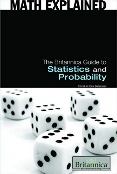-
 Calculating and manipulating the unknown has been the enterprise of the field of algebra since its earliest inception in Babylon and ancient Egypt. Trigonometry draws on principles presented in algebra and uses angle measurements to elaborate on geometric calculations. Essential to further mathematical and scientific study, both algebra and trigonometry provide crucial tools in managing variables and understanding the relationships between them. This volume presents the fundamentals of these fascinating areas of mathematics while chronicling their respective histories.
Calculating and manipulating the unknown has been the enterprise of the field of algebra since its earliest inception in Babylon and ancient Egypt. Trigonometry draws on principles presented in algebra and uses angle measurements to elaborate on geometric calculations. Essential to further mathematical and scientific study, both algebra and trigonometry provide crucial tools in managing variables and understanding the relationships between them. This volume presents the fundamentals of these fascinating areas of mathematics while chronicling their respective histories. -
 Communication and, indeed, our comprehension of the world in general are largely ordered by the number and measurement systems that have arisen over time. Numbers lend structure to human interaction by standardizing the language we use to interpret quantities and by helping us understand natural relationships between varying concepts. This book delves into the history of mathematical reasoning and the progression of numerical thought around the world. With detailed biographies of seminal thinkers and theorists, readers develop a sophisticated understanding of some of the most fundamental arithmetical concepts as well as the individuals who established them.
Communication and, indeed, our comprehension of the world in general are largely ordered by the number and measurement systems that have arisen over time. Numbers lend structure to human interaction by standardizing the language we use to interpret quantities and by helping us understand natural relationships between varying concepts. This book delves into the history of mathematical reasoning and the progression of numerical thought around the world. With detailed biographies of seminal thinkers and theorists, readers develop a sophisticated understanding of some of the most fundamental arithmetical concepts as well as the individuals who established them. -
 Audio and visual cues facilitate some of our most powerful sensory experiences and embed themselves deeply into our memories and subconscious. Sound and light waves interact with our ears and eyesour biological interpreterscreating a textural experience and relationship with the world around us. This well-researched volume explores the science behind acoustics and optics and the broad application they have to everything from listening to music and watching television to ultrasonic and laser technologies that are crucial to the medical field.
Audio and visual cues facilitate some of our most powerful sensory experiences and embed themselves deeply into our memories and subconscious. Sound and light waves interact with our ears and eyesour biological interpreterscreating a textural experience and relationship with the world around us. This well-researched volume explores the science behind acoustics and optics and the broad application they have to everything from listening to music and watching television to ultrasonic and laser technologies that are crucial to the medical field. -
 Common to all matter and its smallest and most fundamental unit, the atom determines the properties of a substance and how it responds to other materials and stimuli. Dividing the atom further reveals several smaller particles whose activity forms the heart of nuclear physics. Readers will discover the structure of the atom as well as the ways in which its electrons, protons, and neutrons facilitate both radioactivity and nuclear reactions, both of which have been crucial to technological advancements since the 20th century.
Common to all matter and its smallest and most fundamental unit, the atom determines the properties of a substance and how it responds to other materials and stimuli. Dividing the atom further reveals several smaller particles whose activity forms the heart of nuclear physics. Readers will discover the structure of the atom as well as the ways in which its electrons, protons, and neutrons facilitate both radioactivity and nuclear reactions, both of which have been crucial to technological advancements since the 20th century.




